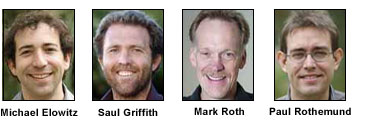
MacArthur Fellows Named
CHICAGO, Sept. 25, 2007 -- Inventor Saul Griffith, nanotechnologist Paul Rothemund, biomedical scientist Mark Roth and molecular biologist Michael Elowitz are among the 24 MacArthur Fellows for 2007 announced today by the John D. and Catherine T. MacArthur Foundation. As recipients of the so-called "genius grants," they each will receive $500,000 -- $100,000 a year for the next five years -- to spend however they wish.
 "These new MacArthur Fellows, extraordinary men and women of all ages and in many fields, honor and inspire us with their talent, their courage, and their deep commitment. With the gift of time and unfettered opportunity to create and explore, we are confident that the Fellows will follow their hearts and their minds wherever they lead, making new discoveries and making a difference in the world," said MacArthur President Jonathan Fanton in a statement.
"These new MacArthur Fellows, extraordinary men and women of all ages and in many fields, honor and inspire us with their talent, their courage, and their deep commitment. With the gift of time and unfettered opportunity to create and explore, we are confident that the Fellows will follow their hearts and their minds wherever they lead, making new discoveries and making a difference in the world," said MacArthur President Jonathan Fanton in a statement.
"As a group, this new class of Fellows takes one's breath away. They are people who will change and influence our times," said Daniel J. Socolow, director of the MacArthur Fellows Program, in the same statement.
2007 MacArthur Fellow Saul Griffith, PhD, cofounding partner of Squid Labs in Alameda, Calif., is an inventor of engineering innovations, with patents spanning optics, high-performance textiles, and nanotechnology. While still a graduate student at the Massachusetts Institute of Technology, he designed a unique membrane-based molding system that can produce a variety of common lenses from a single pair of flexible molding surfaces. This prototype represents a simplified method of producing eyeglass lenses inexpensively enough to serve Third World countries. Other applications may include advanced optics, rapid prototyping, and injection molding, and it continues to be a major focus of research and development at Squid Labs.
Through the Alameda-based spin-off company Potenco, Griffith, who serves as a technical advisor, initiated the project design for a handheld human-powered generator, which has the potential significantly to improve access to electronic devices such as laptops and water purifiers throughout the world.
Nanotechnologist Paul Rothemund, PhD, is a senior research fellow in the departments of Computer Science and Computation and Neural Systems at the California Institute of Technology (Cal Tech) in Pasadena. His work involves folding DNA to create complex shapes and patterns that provide a platform for building advanced nanodevices. Using experimental systems based on macroscopic plastic tiles or DNA, he demonstrated that geometric shapes that are important in computer science can be constructed by self-assembly.
Most recently, Rothemund used long stretches of DNA from a virus that attacks bacteria along with carefully constructed “helper” DNA fragments to create complex, arbitrary shapes such as smiling faces or a map of the Americas, illustrating the potential for self-assembly methods to generate large, nanoscale molecules that offer an extraordinary degree of flexibility and control over their geometry.
Biomedical scientist Mark Roth, PhD, who works in the Basic Sciences Div. of the Fred Hutchinson Cancer Research Center in Seattle, is experimenting with new clinical procedures to temporarily reduce metabolism to provide physicians time to address underlying problems in treating trauma, stroke, cancer and other conditions. He recently found that hydrogen sulfide gas can put mice into a "suspended animation" state that is reversible with no harm to the animals.
Molecular biologist Michael Elowitz's research is laying the groundwork for the next stage of the genomics revolution -- understanding how genes interact. Elowitz, PhD, assistant professor of Biology and Applied Physics at Cal Tech, designs artificial genetic "circuits," first modeling them computationally and then introducing the elements in vivo to test them. Experimenting with the first synthetic biological oscillator, he demonstrated that even relatively simple negative feedback genetic regulation loops can generate complex behavior within a cell. His work revealed that, because of the low concentration of effector molecules, concepts familiar in electronics such as noise and bistability also find currency in explaining gene regulation.
Other MacArthur Fellows announced today include: Cheryl Hayachi of the University of California, Riverside, a spider silk biologist revealing the architecture, properties, and function of spider silks and the possibilities of developing new synthetic materials; robotics researcher Yoky Matsuoka of the University of Washington in Seattle, a leader in the emerging field of neurorobotics who is devising complex prosthetic devices and rehabilitation strategies for the disabled; My Hang Huynh, a chemist at Los Alamos National Laboratory in New Mexico who is devising novel techniques for synthesizing highly energetic compounds; and conservation biologist Claire Kremen of the University of California, Berkeley, who is exploring the behavior of bees and other natural pollinators and their critical role in the global food system.
The number of Fellows selected each year by the MacArthur Foundation's 12-member selection committee is not fixed; typically it varies between 20 and 25. The grants cannot be applied for, and nominations are accepted only from invited nominators. For more information, visit: www.macfound.org
Published: September 2007